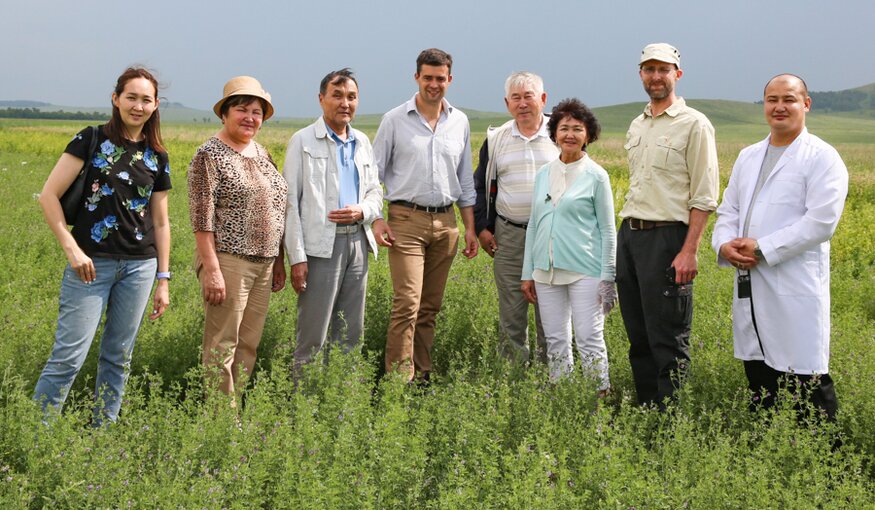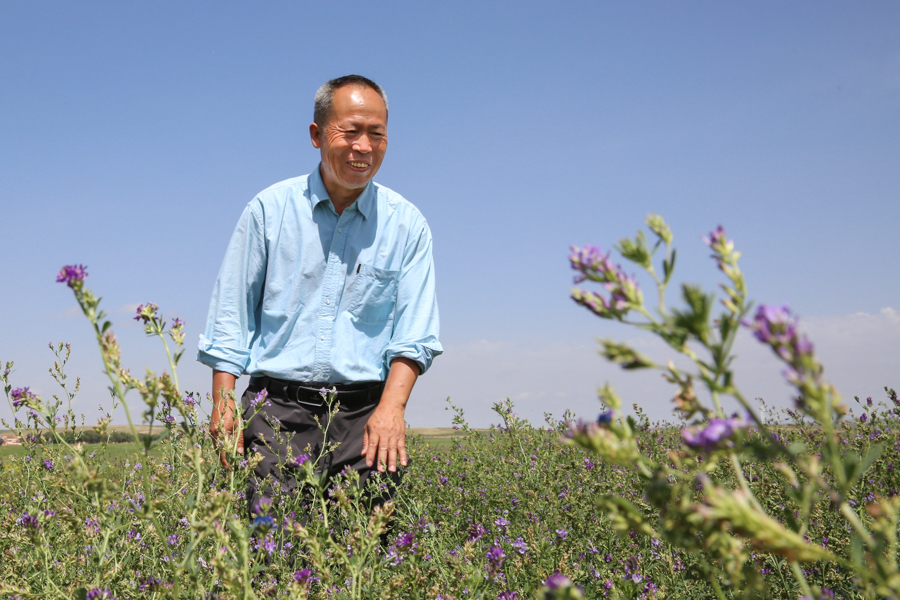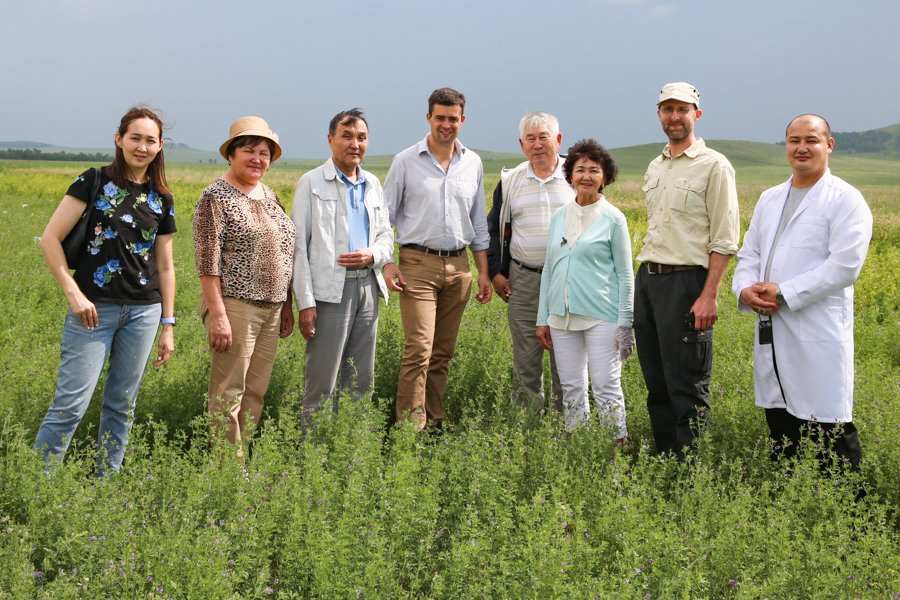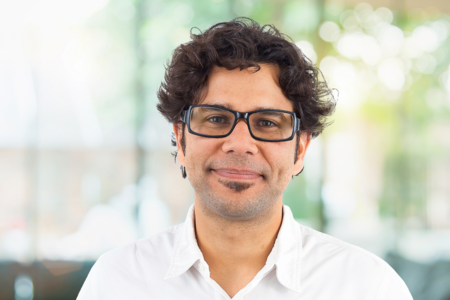Alfalfa Pre-Breeding: Spotlight on Alan Humphries
 Our Crop Wild Relatives alfalfa pre-breeding partners in Kazakhstan (KSRIAPG) are combining the beneficial traits of alfalfa wild relatives with best local varieties to develop new materials for farmers.
Our Crop Wild Relatives alfalfa pre-breeding partners in Kazakhstan (KSRIAPG) are combining the beneficial traits of alfalfa wild relatives with best local varieties to develop new materials for farmers.5 September 2018
LM Salazar | Communications Manager
You might not be familiar with alfalfa, but this member of the pea family is one of the world’s most important crops for feeding livestock. As part of our Crop Wild Relatives project, our partners have spent several years collecting wild relatives of alfalfa in Central Asia. Some of these show great potential for use in developing improved varieties that can tolerate both drought and low temperatures. Alan Humphries, a feed and forage scientist working at the South Australian Research and Development Institute (SARDI) which is the research division of Primary Industries and Regions South Australia (PIRSA), is leading this effort.
I met up with Alan in Kazakhstan recently, where our local CWR alfalfa pre-breeding partner, the Kazakhstan Scientific Research Institute of Agriculture and Plant Growing (KSRIAPG), gave us an impressive whirlwind tour of their trial sites. We started near the city of Almaty in the south and then moved north to Kokshetau. On our last day, I sat with Alan to talk about the project, its challenges and its successes so far, as well as what we can expect in the next phase.

Our Crop Wild Relatives alfalfa pre-breeding partners in China (GRI / CAAS), Chile (Inia Chile), Kazakhstan (KSRIAPG) and Australia (SARDI) are combining the beneficial traits of alfalfa wild relatives with best local varieties to develop new materials for farmers.

Prof. Linqing Yu has been able to introduce new variability into his breeding program. Soon, the best-performing materials from his trials will help improve the overall performance of alfalfa in Inner Mongolia.

Alan Humphries (left) from the South Australian Research and Development Institute (SARDI) leads our four-country Crop Wild Relatives alfalfa pre-breeding project. Pictured here with Ben Kilian, Plant Genetic Resources Scientist at the Global Crop Diversity Trust. Alan is happily impressed by how well some of the Australian varieties in the Kokshetau trials have survived the cold winters in northern Kazakhstan.

In Inner Mongolia, our partners assess field trials in the northern region of the province. These plots are maintained with help from small- and mid-scale farmers. Professor Linqing Yu is evaluating lines here that are drought and cold tolerant.

In Kazakhstan, we saw 'Medicago falcata' everywhere, a yellow-flowered wild relative of alfalfa that is drought and cold tolerant. It is one of the many alfalfa Crop Wild Relatives being crossed with its domesticated counterpart, 'M. sativa', by our pre-breeding partners in China (GRI / CAAS), Chile (Inia Chile), Australia (SARDI) and, of course, Kazakhstan (KSRIAPG).

For most the world, alfalfa is grown as a cut-and-carry crop, to be either conserved as hay or silage, and then fed to animals. This field, in the outskirts of Almaty, will be harvested in July and will help feed the 500 heads of beef cattle owned by Majit Suliev, a mid-scale farmer.

In Kokshetau, in the northern part of Kazakhstan, our KSRIAPG partners are evaluating 54 lines of alfalfa -- crosses with Crop Wild Relatives, as well as materials from other parts of the world, including China and Australia. The temperature range: -38 to 35 Celsius, in a growing season that lasts only 90 days.

Our Crop Wild Relatives alfalfa pre-breeding partners in Kazakhstan (KSRIAPG) are combining the beneficial traits of alfalfa wild relatives with best local varieties to develop new materials for farmers.
LM Salazar: I’m sure our ‘Spotlight’ readers have eaten alfalfa sprouts in their salads or sandwiches before, but some might not know why this crop is so important. Let’s start there.
Alan Humphries: Here in Kazakhstan, around 75 percent of the nation’s milk supply is produced from smallholder farmers that use alfalfa to feed their cows. When I say smallholder, I am taking about people that own no more than five cows. It’s an amazing contribution from a large group of people. And you could say that alfalfa underpins the dairy industry – not only in Kazakhstan, but across the globe.
Alfalfa is a high-yielding, high-protein, perennial forage legume. It has a deep taproot that can access moisture stored deep in the soil, which can extend the growing season during dry conditions. In other words, farmers can harvest highly nutritious green biomass for a longer period of time during the year. Alfalfa is grown all around the world – it is extremely tolerant to both cold (it has been collected from within the northern arctic circle) and hot, dry environments. As a perennial, it can live for up to 10 years, and sometimes for over 50 years. As a legume, it has a symbiosis with rhizobia that it uses to fix nitrogen from the atmosphere – the building blocks for its high protein forage and reason why alfalfa is used to improve soil fertility for following crops.
LS: Tell us, what is the project about?
AH: The world’s climate is rapidly changing, and the low-income subsistence farmers around the world are most vulnerable because they live in marginal food production environments and are least equipped to deal with change. Here in Kazakhstan for example, in Almaty, people look up at the Zailiyskiy Alatau mountains and see less snow every year. That snowmelt is needed for agriculture, as well as supplying drinking water for the communities. Our project aims to help those smallscale and subsistence farmers by introducing new varieties developed from crop wild relatives that grow more biomass with the same or less water. We also aim to improve their agronomy and fodder conservation skills, so that at the end of each season they have more, higher quality feed stored for their dairy cows over winter.
In the diverse environments within the countries participating in the project, we are tackling climate change adaptation in different ways. The common factor is drought, but we are using different germplasm to address the local condition and challenges of each of the environments. Chile and Australia have hot and dry summers, and mild winters. Here in Kazakhstan and in Inner Mongolia (China) the germplasm has to survive extremely cold and dry winters (as low as -38°C) combined with hot summers. Another challenge is the fact that the growing season in northern Kazakhstan is also only around 90 days. So when the growing season begins, the plants have got to really get a motor on. In other parts of the world, the season lasts a good half-a-year; in some areas production can be all year round.
LS: Let’s dive now into the actual activities undertaken by the project partners. What has been keeping you busy for the past three years?
AH: First of all, we’ve managed to assemble a collection of drought-tolerant alfalfas from around the world. These are wild relatives of alfalfa and include the yellow-flowered Medicago falcata, M. ruthenica or shrub species such as M. arborea. We have also searched for and acquired accessions from the Australian, USA and Russian genebanks that have been collected from low rainfall environments or are known for their drought or salinity tolerance.
The next step was to make crosses between the wild relatives and various elite lines from different countries, which have local adaptation. The progenies of these crosses are called pre-bred lines. In the last three-years, we’ve started evaluating them in each of the partner countries – obviously targeting the pre-bred lines that will be very cold-tolerant for northern Kazakhstan and Inner Mongolia.
In every site, we’ve got a common group of around 40 lines, though the trials themselves usually contain somewhere between 50 and 80 entries. We have made a real effort to represent alfalfa accessions from all over the world to maximize diversity and capture different mechanisms for drought tolerance adaptation. Germplasm collected from Kazakhstan and Azerbaijan represent diversity from the center of domestication, but we are also including accessions from secondary domestication centers (Europe, Asia and Africa) where humans have selected alfalfa for over 3000 years.
In each country we are comparing the performance of the pre-bred lines and crop wild relatives in low and high stress environments. Here in Kazakhstan, Almaty (in the south) is the low-stress environment, and in Kokshetau (in the north) is the high-stress cold environment. Then we look at and compare the relative performance of these materials in the two different regions. Additionally, we also look at other larger macro trends that occur between the four countries.
Last year, here in Kokshetau, it got to -38 Celsius, so the drought tolerance for this environment has actually to do with the fact that when soil freezes, all the water is locked up in ice. Thus far, we’re pretty happy and a little bit amazed with how well the germplasm has survived the cold temperatures.
Presently, we’re finalizing the Phase I of the evaluation of these lines’ performance. In Phase II we will expand this evaluation and make available a subset of the material we’ve developed – not just to these partners, but to plant breeders around the world, to be freely available, through a genebank, under the Plant Treaty’s standard material transfer agreement.
LS: This project has brought you to Kazakhstan on several occasions. What can you highlight about this trip?
AH: Firstly, I am very impressed with the effort that the whole team at KSRIAPG has made in the management of their field experiments. The presentation of the sites is very professional and obviously the result of some very hard work. KSRIAPG have done a wonderful job of hosting this visit.
At a scientific level, there are two things that have gained my interest in this trip: firstly, the performance of some new pre-bred lines in southern Kazakhstan. In fact, a cross between a falcata from Kazakhstan and an Australian variety is leading the trial for the early production in the seasons. And I’d be interested to work out how that might be of value for farmers. For example, if they’ve used all their hay through winter, increased early production might be very useful.
The thing that’s interested me in northern Kazakhstan is the general survival of a lot of the varieties. Also, it’s encouraging to see the local breeder here, Prof. Sagalbekov Malgetzhasrovich, getting excited about our work. He’s been breeding for the Kokshetau region for 30 years, and we have encouraged him to select what he wants and use these for his breeding program.
LS: What have been some of the challenges of this project?
AH: Some of these crosses are quite difficult to make. They are time consuming. Also, it is not easy to source and acquire these samples (called accessions in the genebanks context). I’ve put a lot of time, reading Russian textbooks, (Sinskaya), searching through the USDA and the Australian Pastures Genebank* to identify these materials. I’ve used wild falcatas before in my breeding, and from the first cross to having a line ready for final evaluation took at least 12 years, probably closer to 15 years. The pre-bred lines will make it easier for plant breeders to do their job. They won’t have to do that first, difficult cross. Additionally, if we can take three or four years off their workload, that’s incredibly valuable.
There have also been some challenges coordinating seed distribution for evaluation across the four countries. Each has their own quarantine import restrictions, and this takes time. We underestimated this challenge at the beginning of the project. It’s nice now that each group has their core set of germplasm and we know most of the rules for distributing seed to make this process more efficient in the future.
Of course, there have also been some language barriers. My Mandarin, Spanish, Russian/Kazak is extremely limited, so it is highly appreciated that the collaborators make every effort to communicate in English.
LS: Beyond the project partners, have any other colleagues from the alfalfa-breeding world demonstrated any interest in the materials?
AH: Absolutely. We’ve actually delivered a subset of this collection to other groups in China. And we’ve had interest from Spain and Argentina. Within Chile, there’s also a lot more people interested in our work. Whilst we’ve been concentrating on central Chile, there’s now interest from scientists working with farmers in Patagonia, in southern Chile.
We are also fortunate to have Professor Charles Brummer (UC Davis) join our project in the next phase. Professor Brummer will be helping to evaluate the new Medicago arborea x alfalfa hybrids that show enormous potential to increase forage yield in alfalfa under dry conditions.
LS: Speaking about Phase II, what are you looking forward to in the next two years of work?
AH: What I’m excited about in the next phase of the project is actually working with small-holder farmers, engaging with them and trying to make a direct impact in their lives. Of course, there’s different activities planned in each country. Here in Kazakhstan, where alfalfa is already widely grown, we’ll be supporting the introduction of new varieties that have a CWR background. We want to evaluate their performance on farms and compare them to the local Semirechenskaya mestnaya variety, an old variety that’s fairly persistent, but low yielding in comparison to the new varieties.
Another interesting component of Phase II here will be helping to improve the seed production technologies and agronomy. This is where I think we can make an immediate difference. The small-holder farmers that we visited conserved their alfalfa for feeding cows by making hay, but have problems with the weather and availability of hay balers so not all of their hay gets baled and it is often also poor quality. We are going to try and introduce small-scale silage conservation techniques, which will have many advantages. Silage is much better quality than hay and better suited to supporting the nutrition of a dairy cow.
We are also looking at trying to improve local seed production agronomy, to make seed of new varieties more accessible to smallholder farmers. For example, Kazak seed producers rely on the use of wild pollinators – on all sorts of beetles and wasps and flies that pollinate alfalfa, because, obviously, alfalfa here is a native plant. But these insects are not always present in the right density in a commercial field. So we are going to introduce the use of honey bees, which we use in Australia for pollination. That shouldn’t be too challenging; when we are driving along the highway, you see lots of honey for sale in truck stops. It should be a bit of a win-win situation, where the beekeepers will make honey, and we’ll get good pollination for alfalfa.
Briefly, regarding the other countries: Central Chile is interesting because they’ve never grown alfalfa there as a rain-fed plant, only with irrigation. So, in this new phase, our research partners INIA will be distributing 1,000 1-kg packets of seed to smallholder farmers, and there are 20,000 of these farmers in central Chile. In Inner Mongolia, our partner there has a new variety with a CWR introgression from M. falcata that he’s aiming to release soon; there, the project will help improve the seed production and distribution systems for that potential variety. In Australia, we are very excited about the potential of the shrub x alfalfa hybrids (M. arborea x M. sativa) to increase winter and total forage production. Hopefully we can also select for plants with a larger root system from the M. arborea donor, which will make the plant even more drought tolerant.
LS: Last question. As a plant breeder, knowing the challenges you and your colleagues face, how important has it been for the alfalfa research community that our ten-year, global CWR Project chose to support the pre-breeding efforts of this crop?
AH: An international project like this is extremely important for all of the institutes involved, but particularly for my colleagues in Kazakhstan and China. By supporting them, the Crop Trust recognizes the importance of their work within their own organizations (KSRIAPG and GRI).
The benefit to my work at SARDI is also enormous. I have been working with the wild relatives of alfalfa in the Australian Pastures Genebank for some time now. But even so, that work has been limited to our own collection, and we really haven’t had the resources to work beyond the regeneration activities required for conserving the seed. Our alfalfa project has direct links to other Crop Trust projects responsible for collecting and conserving alfalfa crop wild relatives most at risk of local extinction from climate change, providing us with large amounts of new germplasm. This project has given me – and my colleagues in China, Chile, and here in Kazakhstan – a massive opportunity to expand the diversity of the plants that we’re seeing and working with.
At the start of the project, the Crop Trust said to me, “the lines you develop have to be made freely available to researchers around the world.” It’s really nice to be able to give something of value to other plant breeders around the world, and also hopefully to make a positive impact on the lives of small farmers – that’s quite something.
*The Australian Pastures Genebank (APG), operated by the South Australian Research and Development Institute (SARDI) is a partnership between Australian Commonwealth, all State Governments and five industry bodies representing the meat, wool, dairy, seed and grain industries. For more information download the APG Fast Facts document.
Categories: Crop Wild Relatives, Genebanks, Alfalfa

